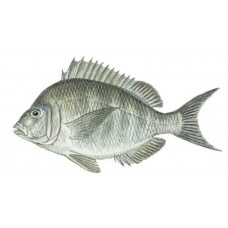Latin name
Stenotomus chrysops
Other names
Scup
Identification
The body is oval, and the pectoral fins are shorter than the length of the head. The bases of the soft dorsal and anal fins are covered with scales. The coloration is brownish; the lower part of the body is silvery. Front teeth are very narrow, almost conical, the chewing teeth on the upper jaw are arranged in two rows. Similar to grunts, but their body is even more flattened laterally, or compressed, and high in front of the dorsal fins. Like some grunts, the eyes are located high on the head and just behind the rear edge of the mouth. The second, or soft, dorsal fin and anal fin are large and roughly the same shape. Most species can change coloration from monochromatic to spotted or streaked and from dark to light, providing better camouflage.
Distribution
Distributed throughout the world in tropical and temperate waters of the Atlantic, Pacific and Indian Oceans, although some enter colder waters. In the U.S. it are predominantly an Atlantic species off the coast. The Jolthead porgy (Calamus bajonado) is one of a large group found in warm waters of the Caribbean and off south Florida, sometimes drifting north with the Gulf Stream to Bermuda. Distinguished by its distinctive shape, it is the largest member of its genus.
Habitat
Sea-bottom fish living at depths of up to 200 m over sandy, muddy-sandy and muddy bottoms. Some live close to shore, others in offshore waters. They are common around reefs, some are found only on sandy bottoms, others live on rocky bottoms.
Size
Length up to 46 cm, weight up to 1.8 kg, age limit 15 years. The usual length in catches is 16-27 cm. They are of medium and small size. The Scup (Stenotomus chrysops) on average does not exceed 10 inches in length, but is one of the most notable representatives of this family. Valued by anglers and commercial fishermen alike along the northeastern and mid-Atlantic coasts of the United States. It becomes sexually mature at the age of two years.
Life history and Behavior
As spring approaches, porgies begin to migrate from their wintering grounds located in open waters between North Carolina and New Jersey, northward and to the shores of New Jersey, New York, and to the southern coast of New England (as far as Massachusetts). Porgies stay here during the summer and early autumn, after which they begin their return migration to wintering at depths of 100-180 m.
Food and feeding habits
It feeds on worms, bivalves and gastropods, squid, amphipods, shrimp, crabs, crustaceans, echinoderms, shellfish, and fish. Rarely, stomachs contain hydroids and even more rarely, algae. Juveniles feed mainly on copepods. They are omnivorous and usually schooling. This group includes species that are harvested for food. Many of them are also a good easy sport for anglers.
Reproduction
The spawning period lasts from May to August, with a peak in June. The caviar is pelagic, its shape is spherical. The eggs are 0.85-1.05 mm in diameter. Embryonic development lasts 40 hours at a water temperature of 22 °C.
| Classification | |
| Phylum | Chordata |
| Class | Actinopterygii |
| Squad | Perciformes |
| Family | Sparidae |
| Genus | Stenotomus |
| Species | S. chrysops |
| Features | |
| Conservation status | Least Concern |
| Habitat | Pelagic |
| Life span, years | 20 |
| Maximum body weight, kg | 2.1 |
| Maximum length, cm | 46 |
| Sailing speed, m/s | No information |
| Threat to people | Edible |
| Way of eating | Predator |
Porgies
Tags: Porgies



